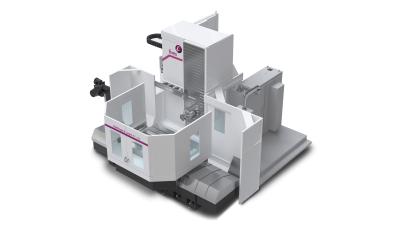
Fives Giddings & Lewis goes toe-to-toe in cost competition by introducing a new line of U.S.-built T-bed boring mills with high accuracy and cutting capacity, but designed and priced for job-shops. T-bed or travelling column boring mills move the column in the Z-axis direction and the tables in X. Engineered for flat-floor installation, small footprint and low-ceiling clearance, the first models of the machine are configured with a 10,000-kg capacity (22,000 lb) 1250 x 1400 mm (49.2 x 55.1 in) contouring rotary table. Optional 1400 x 1800 mm (55.1 x 70.9 in) tables are available.
"These job-shop boring mills are the heavyweights in their class, designed with beefy cast-iron structures, a cross-braced column for torsional stiffness, linear scales, a precision hydrostatic contouring table and 25 kN thrust capacity," said Jim Vadnais, product manager. "We developed these machines to meet specific cost, size, feature and performance targets for job shops, while retaining the premium engineering and build quality our larger machines are known for."
The machines are sized to fit the smaller physical plant of most job shops and toolrooms. Low height and flat-floor installation facilitate machine relocation if necessary. An integral table-mounted pan helps contain chips and coolant. High-end features on the new machines include an electronically counterbalanced Y-axis headstock for superior contouring performance. The sidehung headstock improves visibility and access for the operator. The spindle snout reaches over the table for rigid cutting without extension and with spindle travel extends well beyond center. In addition, the spindle can reach below table top to probe for location on the table or a particular feature.
Permanently greased spindle bearings reduce maintenance. The zero-backlash rotary table is powered by two independent motors and pinion drives that are tensioned against each other to compensate for any lost motion.
The new Giddings & Lewis RT 130 and RT 155 boring mills feature 130 or 155 mm (5.1 or 6.1 in) diameter gear-driven spindles available with up to 45 kW (60 hp) and 3380 Nm (2493 ft lb) torque. All spindles are size 50 tool taper, and equipped with Giddings & Lewis' exclusive spindle thermal growth compensation.
Heavy-duty linear ways on these machines utilize roller bearing carriages that ride on hardened and ground guideways. This rigid, low-friction system supports high loads and fast traverse speeds By eliminating the stick-slip and thermal growth common to box ways, linear ways facilitate better true positioning and contouring accuracy. They also require less lubrication, thus reducing coolant contamination. Standard X-Y-Z axis travels are 2,000, 1,500 and 1,600 mm (78.7, 59.1, 63 in) with W-axis spindle travel of 750 mm (29.5 in).
All CNCs for the new machines are equipped with Fives Machining Systems new Diagnostic Communications System (DCS). The DCS allows customers to connect with Global Service technicians on a secure system to review active alarms and operator messages, operator and alarm histories, control parameter settings, PLC programs and the state of devices such as solenoids, switches and encoders. According to Fives, 30 to 40 percent of stoppages can be
overcome immediately this way without waiting for a service call.
Contact Details
Related Glossary Terms
- boring
boring
Enlarging a hole that already has been drilled or cored. Generally, it is an operation of truing the previously drilled hole with a single-point, lathe-type tool. Boring is essentially internal turning, in that usually a single-point cutting tool forms the internal shape. Some tools are available with two cutting edges to balance cutting forces.
- clearance
clearance
Space provided behind a tool’s land or relief to prevent rubbing and subsequent premature deterioration of the tool. See land; relief.
- coolant
coolant
Fluid that reduces temperature buildup at the tool/workpiece interface during machining. Normally takes the form of a liquid such as soluble or chemical mixtures (semisynthetic, synthetic) but can be pressurized air or other gas. Because of water’s ability to absorb great quantities of heat, it is widely used as a coolant and vehicle for various cutting compounds, with the water-to-compound ratio varying with the machining task. See cutting fluid; semisynthetic cutting fluid; soluble-oil cutting fluid; synthetic cutting fluid.
- stiffness
stiffness
1. Ability of a material or part to resist elastic deflection. 2. The rate of stress with respect to strain; the greater the stress required to produce a given strain, the stiffer the material is said to be. See dynamic stiffness; static stiffness.
